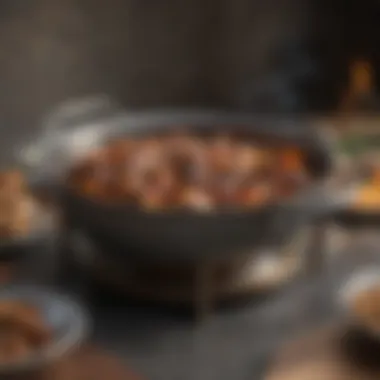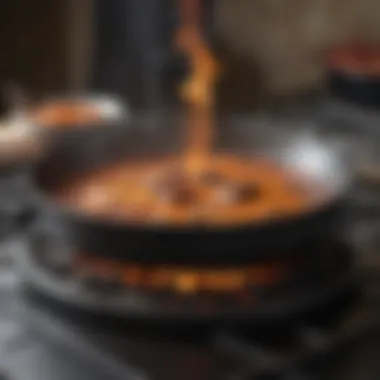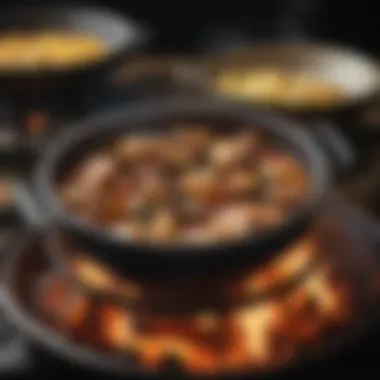A Comprehensive Guide to the Brazier Pan


Intro
The brazier pan has carved its niche in the culinary world, embodying both practicality and adaptability. This kitchen tool, often overlooked, is valuable for a multitude of cooking methods. Whether you are braising, searing, or slow-cooking, a brazier pan can elevate the dishes you prepare. By understanding its features and capabilities, home cooks and aspiring chefs alike can take full advantage of this essential item.
The historical context of brazier pans traces back to their use in professional kitchens, where their functionality became evident. As the culinary landscape evolved, so did the brazier pan, adapting to suit a variety of cooking styles in home kitchens. Today, this pan is recognized for its capacity to retain heat, making it ideal for cooking food evenly across its surface.
Using a brazier pan can enhance your cooking experience. With this guide, we will explore the characteristics of brazier pans, their different materials, sizes, and designs, along with practical tips for care and maintenance. Additionally, we will delve into recipes that exemplify the pan's versatility.
This knowledge aims to enrich your culinary skills and inspire you to integrate the brazier pan into your daily cooking routines. Let us begin by surveying the various recipes that showcase the unique capabilities of a brazier pan.
Understanding the Brazier Pan
The brazier pan holds a significant place in the kitchen for its versatile use and functionality. Its design and purpose make it suitable for various cooking methods, from braising to simmering. This section provides clarity on what defines a brazier pan and its relevance in culinary practices today.
Definition and Overview
A brazier pan is a wide, deep, and typically heavy pot with a flat bottom and straight sides. It often features a lid, making it suitable for moist cooking techniques. Crafted from materials such as stainless steel, cast iron, and non-stick substances, the brazier pan is adaptable in both home and professional kitchens. Its integral role in cooking revolves around retaining heat and moisture, which promotes tender and flavorful dishes.
Braising is one of its signature cooking techniques. In this process, the food is cooked slowly with a small amount of liquid. This technique enhances the flavors while ensuring that meats and vegetables remain moist. Given these features, a brazier pan becomes an essential tool for anyone interested in exploring deeper culinary skills.
Historical Significance
The history of the brazier pan traces back to ancient civilizations where cooking was done over open flame. Original forms of brazier pans were forged from clay or primitive metals. Over time, as cooking methods evolved, so did the materials and design of the brazier pan. Notably, the cast iron versions became popular due to superior heat retention.
Throughout history, various cultures have utilized the brazier pan for cooking. In Mediterranean regions, it has been a staple for preparing stews. In Asian cuisines, similar pans, sometimes called wok or kadai, adapted the same techniques for stir-frying and slow cooking. The evolution of the brazier demonstrates how cooking styles have changed while maintaining the core principle of slow-cooked, flavorful meals.
Cultural Contexts
The brazier pan showcases versatility across different cultures. For instance, in French cooking, it is often used for coq au vin, a traditional dish that embodies rich, tender textures. In the Italian culinary world, the brazier pan is crucial for preparing osso buco, emphasizing the pan's ability to distribute heat evenly.
Regions around the world have their unique adaptations of the brazier pan. In Brazilian cooking, it is employed for making feijoada, a slow-cooked bean stew. Throughout Africa, similar pots are used for cooking stews rich in spices and flavors.
In summary, understanding the brazier pan highlights its enduring significance in culinary traditions. The intersection of function and history enriches modern cooking practices, making it an invaluable addition to every kitchen.
Features of a Brazier Pan
Understanding the features of a brazier pan is essential for maximizing its potential in cooking. This section highlights the materials used, the various sizes and shapes available, and important design considerations. Each element plays a crucial role in the pan's performance and usability. By exploring these features, readers can make more informed choices, which can significantly affect their cooking experiences.
Materials Used
The materials of a brazier pan greatly influence its functionality and durability in the kitchen. Different materials come with unique characteristics that cater to various cooking needs.
Stainless Steel
Stainless steel is a favored choice for brazier pans due to its durability and resistance to corrosion. This material does not react with acidic foods, allowing for a broad range of culinary applications. Its non-reactive nature is a significant advantage for those who desire the purity of flavors in their dishes. However, it can be less effective for heat retention compared to other materials. For many cooks, the easy maintenance and sleek appearance of stainless steel make it an appealing option.
Cast Iron
Cast iron is renowned for its exceptional heat retention and distribution properties. This results in even cooking, making it ideal for methods like braising and slow cooking. With proper seasoning, cast iron can become naturally non-stick and develop a rich patina over time. However, it requires more maintenance to prevent rust and can be very heavy. Despite this, many enthusiasts appreciate the depth of flavor it can impart to dishes.
Non-Stick Options


Non-stick brazier pans are designed to prevent food from sticking, making cooking and cleaning much easier. These pans typically feature a coating that allows for low-fat cooking options, appealing to health-conscious users. However, the longevity of non-stick coatings can vary, and they generally require gentle handling to avoid scratching. For those who prioritize convenience, non-stick options can be very beneficial, although they may not provide the same high-temperature versatility as stainless steel or cast iron.
Sizes and Shapes
The size and shape of a brazier pan can impact the cooking process and the type of dishes that can be prepared.
Standard Sizes
Brazier pans come in various standard sizes, ranging from small to large. The choice of size often depends on the portion of food being prepared. A larger pan can accommodate bigger batches, which is especially useful for family meals or gatherings. However, smaller pans may be more suited for daily cooking or for meals that do not require extensive servings. A careful consideration of size helps in managing cooking times and resources effectively.
Shapes for Different Uses
Different shapes of brazier pans can enhance their effectiveness for specific cooking methods. For example, a wide, shallow design is ideal for browning and searing, while deeper models excel in slow cooking and braising. The shape also affects heat distribution, which is important for maintaining even cooking. Choosing the right shape can significantly influence the final outcome of a dish, making it an essential factor for cooks.
Design Considerations
The design of a brazier pan is vital for its usability and effectiveness in the kitchen.
Handle Types
Handles of brazier pans come in various designs, impacting the ease of handling and cooking experience. Long, sturdy handles often provide better leverage and heat resistance, which is important when moving the pan from heat sources. Some pans feature ergonomic designs that improve grip. However, the placement and structure of handles can also affect the balance of the pan when lifting. A well-designed handle ensures safety and comfort during use.
Weight and Balance
The weight of a brazier pan plays a significant role in its stability during cooking. Heavier pans typically provide improved heat retention and even cooking. However, they can be challenging to maneuver, especially for those with less upper body strength. Balanced pans help to create a sense of security when handling hot food. A thoughtful consideration of weight and balance can enhance cooking efficiency and safety in the kitchen.
"Consider the materials, sizes, and design features of a brazier pan while selecting the right one for your culinary needs."
Benefits of Using a Brazier Pan
The brazier pan holds significant advantages for both novice and experienced cooks. Its inherent versatility makes it suitable for various cooking techniques, from high-heat methods to low, slow preparations. The ability to adapt a brazier pan to different recipes reinforces its status as a kitchen essential. Moreover, a brazier pan's design contributes to its effectiveness in distributing heat evenly, enhancing the flavors of the dishes prepared within it. Understanding these benefits is vital for those looking to elevate their culinary experiences.
Versatility in Cooking
Searing
Searing is one of the most popular techniques utilized with a brazier pan. This method involves cooking food at high temperatures to create a caramelized crust. The pan’s thick base ensures that high heat is retained, making it perfect for searing meats. This characteristic is crucial, as it not only enhances the flavor but also locks in moisture.
A unique feature of searing is the immediate flavor development that occurs. When meat is seared, it develops what is often referred to as the Maillard reaction. This adds depth to dishes and promotes a rich, savory taste. However, it requires careful temperature control to avoid burning.
Slow Cooking
Slow cooking is another technique that greatly benefits from the design of a brazier pan. This method allows flavors to meld, developing a rich, complex profile over extended cooking periods. The heavy materials often found in brazier pans are ideal for this. They provide steady, consistent heat that penetrates the food evenly.
A key characteristic of slow cooking is its simplicity. After initial preparation, the dish can be left to cook with little intervention. This makes it an excellent choice for busy home cooks. While this method is generally energy-efficient, it does take much longer than other cooking techniques.
Steaming
Steaming is an essential technique that can also be performed using a brazier pan. This method helps maintain the nutrients and flavors in food, making it a healthy cooking option. Many braziers come with a steaming insert or lid that allows for steaming above simmering liquid inside the pan.
The key characteristic of steaming is its ability to cook food without added fats or oils. This method is becoming increasingly favorable, especially for health-conscious individuals. An advantage of steaming, however, is that it may not always produce the rich, deep flavors found in other cooking methods.


Even Heat Distribution
The brazier pan’s structure is specifically designed for even heat distribution. This means that cooking surfaces are uniformly heated, reducing hot spots that can burn food or leave areas undercooked. When using a brazier pan, home cooks can be more confident about the outcome of their dishes. Even heat distribution ensures that ingredients cook at the same rate, providing a consistent texture and flavor throughout the dish.
Durability and Longevity
Durability is another undeniable benefit of the brazier pan. Many models are constructed from materials such as cast iron or high-grade stainless steel, which can withstand high temperatures and resist wear over time. This feature makes the brazier pan a worthwhile investment for any kitchen.
The longevity of a brazier pan will also depend on proper care and maintenance, which is relatively easy. Appropriate cleaning and techniques like seasoning for cast iron versions can significantly extend the life of these pans. Therefore, by choosing a brazier pan, cooks not only acquire a versatile cooking tool but also one that can serve them well for many years.
Cooking Techniques with a Brazier Pan
Understanding various cooking techniques with a brazier pan significantly enhances its utilization in the kitchen. The brazier pan is designed for both function and efficiency, making it a versatile tool for multiple culinary methods. Utilizing appropriate techniques allows cooks to maximize flavor and texture in their dishes. It is essential to embrace these methods not only to refine cooking skills but also to elevate the overall eating experience.
Braising Basics
Braising is a cooking technique that involves both moist and dry heat. It is particularly well-suited for tougher cuts of meat that require time to become tender. The process usually starts with searing the meat in the brazier pan to develop deep flavors. After browning, liquid is added to the pan, covering the meat partially. The lid is secured, and the dish is cooked slowly either on the stovetop or in the oven. The low heat allows the connective tissues in the meat to break down, resulting in a tender, flavorful outcome. Braun sausages, a classic dish, are often braised in a rich stock or wine to enhance their natural flavor, showcasing the full potential of this technique.
Searing and Deglazing
Searing is an important step for building flavor. It involves cooking food at high heat until a brown crust forms. This caramelization is vital as it adds depth to the dish. A brazier pan is perfect for this technique because of its heavy base, which provides excellent heat retention.
Once searing is done, deglazing the pan is the next important step. By adding a liquid, such as broth, wine, or even water, the brown bits stuck to the pan - known as fond - are released. These bits contain concentrated flavors that enhance any sauce or broth created afterward. This not only makes the dish richer but also showcases the essence of the ingredients used. Make this process a habit when cooking with a brazier pan, as it allows every layer of flavor to shine.
Using Low Heat for Slow Cook Dishes
Cooking on low heat is particularly beneficial for slow-cooked dishes. The brazier pan's design allows it to maintain consistent temperatures, making it an excellent choice for recipes requiring a longer cooking time. One notable advantage of cooking on low heat is the ability to meld flavors together gradually. Dishes like chili or pot roast become much tastier when allowed to simmer slowly, allowing spices and aromatics to permeate the food thoroughly.
In addition, low-heat cooking reduces the risk of burning or overcooking delicate ingredients, something particularly important when preparing dishes with vegetables. Using the brazier pan in this way promotes a harmonious blending of flavors, resulting in meals that feel both comforting and satisfying.
In summary, mastering cooking techniques with a brazier pan is essential for any enthusiast looking to expand their culinary repertoire. The adaptability of the brazier pan enables cooks to explore various methods, each with its benefits and focus on flavor development. With these techniques in hand, home chefs can maximize the potential of their brazier pans.
Recipes to Try with a Brazier Pan
Exploring recipes to utilize with a brazier pan is essential for fully appreciating its capabilities in the kitchen. This section highlights the flexibility and adaptability of the brazier pan, detailing how it can handle various cooking methods. The importance lies in showcasing how specific dishes can benefit from the even heat distribution and ample cooking space that a brazier pan provides.
Home cooks can enhance their culinary skills and enjoy the rich flavors that come from well-cooked ingredients. Understanding these recipes allows readers to maximize the use of their brazier pan and experiment confidently in the kitchen.
Classic Beef Braise
Beef braise is a timeless dish that perfectly illustrates the prowess of the brazier pan. The process begins with searing the beef on high heat, creating a caramelized crust. This step locks in flavors and prepares the meat for the slow cooking phase.
After searing, the heat is lowered, and aromatics such as onions, garlic, and spices are added. These ingredients create a flavorful base for the braising liquid. Red wine or stock is commonly used, enriching the dish. The brazier pan's lid traps moisture, ensuring that the beef becomes tender over hours of cooking.
It's key to let the dish sit after cooking, allowing flavors to meld. Serve this dish with mashed potatoes or crusty bread to complete the meal.
Vegetable Medley Stew
Vegetable medley stew is an excellent choice for those seeking a hearty, plant-based option. The advantage of a brazier pan is its ability to handle a variety of vegetables simultaneously, ensuring even cooking without them becoming mushy.
Start by sautéing onions and garlic in the pan, creating a fragrant foundation. Next, add vegetables such as carrots, bell peppers, and zucchini. Consider incorporating hearty greens like kale or spinach for additional nutrition. Pour in vegetable broth and season with herbs like thyme or rosemary.


The low, slow cooking allows the veggies to absorb the flavors while maintaining their structure. This stew is versatile and can be served hot or cold, making it a year-round staple.
Herb-Infused Chicken
Herb-infused chicken demonstrates the effectiveness of a brazier pan for poultry dishes. Start with chicken thighs or breasts, as they tend to remain moist during cooking. First, season the chicken with a blend of herbs like sage, thyme, and parsley. A drizzle of olive oil enhances the flavor and promotes browning.
Sear the chicken in the brazier pan to achieve a golden crust. After flipping the chicken, you can add vegetables such as shallots and carrots around the meat. Pour in a small amount of white wine or chicken stock to keep the dish moist.
Cover the pan and let it simmer on low heat. The chicken absorbs the herb flavors, resulting in a succulent dish. Serve with rice or quinoa to soak up the juices.
Remember, the versatility of the brazier pan allows for experimentation. Don't hesitate to adjust flavors or ingredients according to your tastes.
These recipes exemplify the various ways a brazier pan can enhance cooking experiences. By taking advantage of its unique properties, home cooks can create vibrant, delicious meals that elevate their culinary endeavors.
Maintaining and Caring for a Brazier Pan
Maintaining and caring for a brazier pan is essential for ensuring its longevity and performance in the kitchen. A well-cared-for brazier pan retains its effective heat distribution and non-stick properties, which are crucial for achieving excellent culinary results. The process of cleaning, seasoning, and storing these pans may seem straightforward, but each step plays a critical role in preserving the integrity of the material, particularly for cast iron. Moreover, proper care enhances the overall cooking experience, minimizing potential issues like rust or poor food release.
Cleaning Guidelines
Keeping the brazier pan clean is necessary to prevent flavors from lingering and to ensure that the food cooked within it remains fresh. Here are some guidelines:
- Cooling Down: Allow the pan to cool completely before cleaning. Sudden temperature changes can warp the material.
- Basic Cleaning: For most materials, simply use warm water and a soft sponge to remove food residue. Avoid using harsh abrasives, as these can scratch the surface.
- Stubborn Stains: For tougher stains, a gentle scrub with baking soda and water can be effective. Create a paste and apply it, letting it sit for a few minutes before scrubbing lightly.
- Avoid Soaking: Do not soak the pan in water as this can damage the materials, particularly for cast iron.
- Rinse Thoroughly: Always make sure to rinse the pan thoroughly to remove any soap residue, which can affect food flavor.
Tip: For stainless steel braziers, a mixture of vinegar and water can help maintain their shine and remove any discoloration.
Seasoning Cast Iron Variants
Seasoning is a critical step when it comes to maintaining cast iron brazier pans. This process not only adds a natural non-stick surface but also protects the pan from rust. Here’s how to properly season your cast iron:
- Clean: Start with a clean, dry pan. Remove any old seasoning or rust using steel wool if necessary.
- Apply Oil: Use a thin layer of vegetable oil or a specialized cast iron seasoning oil. Make sure to cover the entire surface area, inside and out.
- Heat: Preheat your oven to 350°F (175°C). Place the pan upside down on the middle rack. This prevents oil from pooling in the pan.
- Bake: Let the pan bake for about one hour. This will allow the oil to polymerize and create a durable non-stick coating.
- Cool Down: Turn off the oven and let the pan cool inside before removing it.
Regularly seasoning your cast iron brazier will enhance its cooking performance and prevent rusting.
Storage Recommendations
Proper storage is as important as cleaning and seasoning to maintain the quality of your brazier pan. Here are some recommendations:
- Keep It Dry: Always store the pan in a dry place to prevent moisture buildup, which can lead to rust.
- Stacking: If you stack your pans, place a cloth or paper towel between them. This prevents scratching and preserves seasoning.
- Avoid Plastic Bins: Plastic containers can trap moisture. Opt for metal or wooden racks for better air circulation.
By taking these steps, you can ensure that your brazier pan remains in excellent condition for years to come. Maintaining its care translates to a more enjoyable and effective cooking experience.
Culmination: Embracing the Brazier Pan in Modern Cooking
The brazier pan serves as a bridge between traditional cooking methods and contemporary culinary practices. Recognizing its relevance in today’s kitchens is crucial for anyone who seeks efficiency alongside aesthetic appeal in their cooking. The versatility offered by a brazier pan not only enhances the cooking experience but also allows it to fit seamlessly into various cooking styles and routines.
Final Thoughts on Utility
Embracing a brazier pan means acknowledging its utility in cooking different types of dishes. It is not merely a cooking tool but a catalyst for flavor development. When used properly, it can transform simple ingredients into gourmet meals. Whether you are braising meats, slow cooking vegetables, or simmering sauces, the brazier pan’s unique design ensures even heat distribution. This is particularly beneficial for recipes that require precision and attention to detail.
Moreover, one cannot overlook its durability. Many brazier pans, especially those made from cast iron, can withstand high temperatures and are built to last. This characteristic not only leads to better cooking results but also a worthwhile investment in your kitchen arsenal. With proper care, these pans can serve you for years, if not generations.
Encouragement for Experimentation
When it comes to cooking, experimentation should be seen as an opportunity rather than a risk. The brazier pan invites cooks to explore different techniques and flavors. For those willing to step outside their culinary comfort zones, this pan can be the perfect partner. Adjusting heat levels, trying various herbs and spices, or even combining different cooking methods can yield delicious results.
Using a brazier pan encourages an understanding of how elements interact in the cooking process. This deepening knowledge helps refine cooking skills and enhances creativity in the kitchen. The more one uses a brazier pan, the more one discovers its capabilities and potential.
In summary, the brazier pan is not just a tool; it is a gateway to enhancing your culinary skills. As one integrates the brazier pan into their cooking routine, each use becomes a learning experience. By fully embracing what this pan offers, any cook can sharpen their skills and develop a richer culinary repertoire.















